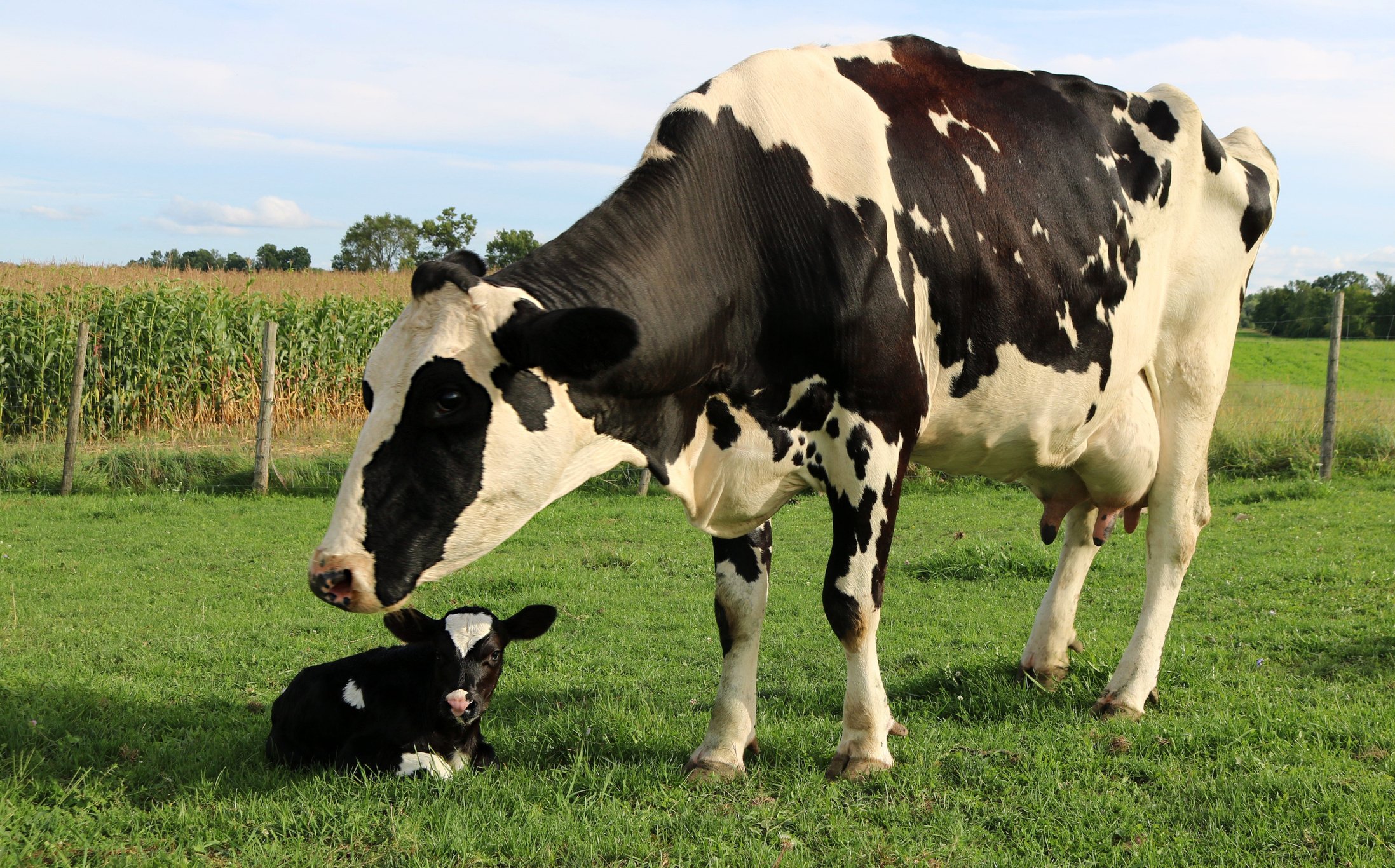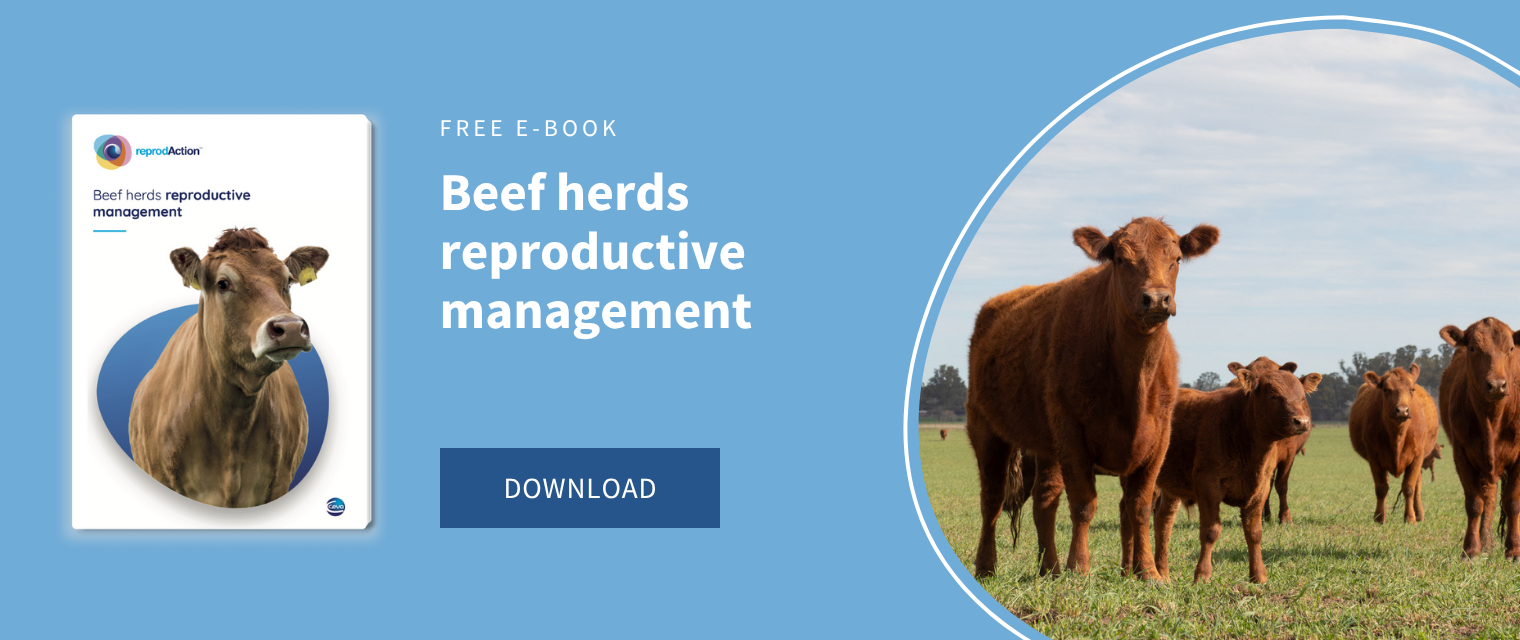Introduction
Progesterone (P4) plays a central role in establishing pregnancy and ensuring fertility success in cattle breeding. In this article we highlight some recent findings in relation to embryo maternal interaction during bovine pregnancy establishment and the role of P4 in uterine biology and embryo development. Understanding these mechanisms is key to improving reproductive efficiency and pregnancy outcomes in modern cattle breeding programs. For a more comprehensive treatment, the reader is referred to some of the numerous detailed reviews listed in the reference section (e.g., Wiltbank et al., 2014; Lonergan and Sánchez, 2020; Spencer et al., 2016).
Prefer to listen to this article? Click the play button below and enjoy our podcast!
How progesterone and early embryo development impact fertility in cattle breeding
Fertility is one of the main drivers of profitability in livestock production systems. Successful pregnancy establishment involves ovulation of a good quality oocyte, fertilisation by a capacitated sperm and growth of the embryo in a reproductive tract environment conducive to normal development. Following fertilisation in the oviduct, the bovine embryo enters the uterus at about the 16-cell stage on approximately day (d) 4 of pregnancy. By d 7, the embryo has formed a blastocyst consisting of an inner cell mass, which after further differentiation gives rise to the embryo/foetus, and the trophectoderm, which ultimately forms the placenta. After hatching on d 8 to 9, the blastocyst undergoes a change in morphology from a spherical to ovoid shape during a transitory phase preceding the elongation or outgrowth of the trophectoderm to a filamentous form that usually begins between d 12 and 14. Around this time, the trophectoderm cells of the conceptus begin to secrete significant amounts of interferon-tau (IFNT), the pregnancy recognition factor in cattle, which ultimately block the uterine luteolytic mechanism to ensure maintenance of a functional corpus luteum (CL) for production of progesterone (P4). Attachment of the conceptus to the endometrium occurs around d 20 in cattle and signals the start of implantation. This is a critical period of development as most embryonic loss occurs during this window.
Circulating concentrations of P4 represent a balance between production and metabolism of P4 (Wiltbank et al., 2014). Elevated P4 during growth of the preovulatory follicle have been shown to increase pregnancy per AI (P/AI). Low circulating concentrations of P4 near AI, indicative of optimal CL regression, are required to optimize fertility, while elevated P4 concentrations after AI can impact embryonic development and may, in some circumstances, improve fertility. Thus, strategies to optimize P4 concentrations during selected reproductive periods may improve reproductive efficiency of lactating dairy cows.
The role of progesterone in oocyte quality and fertility in cattle breeding
High P4 concentrations during the growth of the ovulatory follicle are associated with improved oocyte quality and pregnancy outcomes (Pursley and Martins, 2011). During the final period of follicle growth prior to ovulation, the follicular fluid changes from an environment dominated by oestradiol (which brings the cow into oestrus) to one that is dominated by P4, as the granulosa cells luteinize in preparation for the formation of the CL after ovulation. Given that this period is coincident with resumption of meiosis and maturation of the oocyte, a role for P4 in determining oocyte quality is likely.
Reduced P4 concentrations as seen during growth of the first follicular wave when the CL is still developing negatively affect embryo quality after superstimulation (Rivera et al., 2011; Nasser et al., 2011) and reduces pregnancies per AI (P/AI) of lactating dairy cows (Denicol et al., 2012); in both scenarios, outcomes can be improved by supplementing with exogenous P4 via an intravaginal device. Based on such studies, sophisticated hormonal synchronization protocols have been incorporated widely into reproductive management programs (Carvalho et al., 2018), many of which incorporate a P4 device or other strategy to ensure elevated P4, such as induction of an accessory CL.
How progesterone regulates uterine receptivity in dairy cattle
The relationship between circulating P4 and uterine receptivity has been well described. Progesterone priming of the uterus is essential for optimal pregnancy establishment. As the CL develops following ovulation, the uterus is exposed to increasing concentrations of P4 which alter the gene expression pattern (transcriptome) of the endometrium (Forde et al., 2009). Elevated P4 concentrations in the first week after conception have been associated with accelerated post-hatching conceptus elongation, mediated through advancement in the regular temporal changes in the uterine endometrial gene transcriptome and alterations in the uterine lumen fluid (ULF) composition (which supports the developing embryo). This is important because short (retarded) conceptuses exhibit a different gene expression pattern to their longer age-matched counterparts and such short conceptuses produce less IFNT and fail to elicit an appropriate response from the endometrium around the time of pregnancy recognition (Sánchez et al., 2019).
Progesterone supplementation strategies for improved fertility
Many studies have attempted to improve fertility in cattle by elevating P4 after AI. Approaches taken to increase peripheral concentrations of P4 after artificial insemination, include those that:
- Increase function of the existing CL (e.g., promote growth of the dominant follicle before ovulation resulting in a larger CL, or luteotrophic treatments which stimulate CL development.
- Induce ovulation of a dominant follicle and formation of accessory CL.
- Those which supplement progesterone directly (e.g., via injection or intravaginal devices).
Data on outcome in terms of pregnancy rate are often conflicting or inconclusive. Thus, while a significant volume of research has provided insight into the mechanisms regulating circulating P4 concentrations and actions on the uterus and conceptus, more research is required to best understand how P4 manipulation can be repeatedly used to improve reproductive success.
Conclusion
Low P4 concentrations have been implicated as a causative factor in low pregnancy rates observed in high-yielding dairy cows. Optimal P4 during growth of the pre-ovulatory follicle results in improved outcomes, presumably through effects on the quality of the ovulated oocyte. Elevated concentrations of P4 in the immediate post-conception period have been associated with an advancement of conceptus elongation, an increase in IFNT production and higher pregnancy rates in cattle. Elevated P4 advances the transcriptomic changes in the endometrium which normally occur during pregnancy resulting in enhanced conceptus elongation; this positive effect on conceptus growth is mediated via P4-induced changes in the endometrial transcriptome. Innovative strategies aimed at optimising circulating concentrations of P4 pre- and post-conception have the potential to improve embryo survival in cattle. Emerging data indicate that the time of conceptus attachment to the endometrium, which occurs around d 20 of pregnancy in cattle, is critical for pregnancy success. In particular, late attachment significantly increases the likelihood of losing the pregnancy. Whether elevated P4, which accelerates conceptus elongation, is associated with earlier conceptus attachment remains to be fully tested.
Take-home messages
- Successful growth and development of the embryo and establishment of pregnancy are a result of the interaction between a good quality embryo and a receptive uterine environment.
- The steroid hormone progesterone (P4) plays a key role in reproductive events associated with establishment and maintenance of pregnancy – prior to ovulation, through its effects on oocyte quality in the ovarian follicle and, after ovulation, through its action on the uterine endometrium.
- Elevated P4 during growth of the preovulatory follicle is essential to optimise fertility
- Low concentrations of circulating P4 after ovulation are associated with a reduction in conceptus growth and elongation, a decrease in interferon-tau production (the pregnancy recognition factor in ruminants) and lower pregnancy rates.
- Elevating concentrations of circulating P4 in the immediate post-conception period is associated with an acceleration of conceptus elongation, an increase in interferon-tau production and, in some cases, higher pregnancy rates.
References
Carvalho PD, Santos VG, Giordano JO, Wiltbank MC, Fricke PM. Development of fertility programs to achieve high 21-day pregnancy rates in high-producing dairy cows. Theriogenology. 2018;114:165-172. doi: 10.1016/j.theriogenology.2018.03.037.
Denicol AC, Lopes G Jr, Mendonça LG, Rivera FA, Guagnini F, Perez RV, Lima JR, Bruno RG, Santos JE, Chebel RC. Low progesterone concentration during the development of the first follicular wave reduces pregnancy per insemination of lactating dairy cows. J Dairy Sci. 2012;95(4):1794-806. doi: 10.3168/jds.2011-4650.
Forde N, Carter F, Fair T, Crowe MA, Evans AC, Spencer TE, Bazer FW, McBride R, Boland MP, O'Gaora P, Lonergan P, Roche JF. Progesterone-regulated changes in endometrial gene expression contribute to advanced conceptus development in cattle. Biol Reprod. 2009;81(4):784-94. doi: 10.1095/biolreprod.108.074336.
Lonergan P, Sánchez JM. Symposium review: Progesterone effects on early embryo development in cattle. J Dairy Sci. 2020;103(9):8698-8707. doi: 10.3168/jds.2020-18583.
Nasser LF, Sá Filho MF, Reis EL, Rezende CR, Mapletoft RJ, Bó GA, Baruselli PS. Exogenous progesterone enhances ova and embryo quality following superstimulation of the first follicular wave in Nelore (Bos indicus) donors. Theriogenology. 2011;76(2):320-7. doi: 10.1016/j.theriogenology.2011.02.009.
Pursley JR, Martins JP. Impact of circulating concentrations of progesterone and antral age of the ovulatory follicle on fertility of high-producing lactating dairy cows. Reprod Fertil Dev. 2011;24(1):267-71. doi: 10.1071/RD11917.
Rivera FA, Mendonça LG, Lopes G Jr, Santos JE, Perez RV, Amstalden M, Correa-Calderón A, Chebel RC. Reduced progesterone concentration during growth of the first follicular wave affects embryo quality but has no effect on embryo survival post transfer in lactating dairy cows. Reproduction. 2011;141(3):333-42. doi: 10.1530/REP-10-0375.
Sánchez JM, Mathew DJ, Behura SK, Passaro C, Charpigny G, Butler ST, Spencer TE, Lonergan P. Bovine endometrium responds differentially to age-matched short and long conceptuses. Biol Reprod. 2019;101(1):26-39. doi: 10.1093/biolre/ioz060.
Spencer TE, Forde N, Lonergan P. The role of progesterone and conceptus-derived factors in uterine biology during early pregnancy in ruminants. J Dairy Sci. 2016;99(7):5941-5950. doi: 10.3168/jds.2015-10070.
Wiltbank MC, Souza AH, Carvalho PD, Cunha AP, Giordano JO, Fricke PM, Baez GM, Diskin MG. Physiological and practical effects of progesterone on reproduction in dairy cattle. Animal. 2014;8 Suppl 1:70-81. doi: 10.1017/S1751731114000585.
About the author
Pat Lonergan (Professor of Animal Reproduction at University College Dublin)
Pat Lonergan is Professor of Animal Reproduction at University College Dublin. His research focuses on understanding the regulation of embryo development in vivo and in vitro, embryo maternal communication and the establishment of pregnancy in cattle as well as aspects of bull fertility including the contribution of the sire to embryo mortality and overall herd fertility. He is a long-time member and Past President of the International Embryo Technology Society, served on the board of Association of Embryo Transfer in Europe (AETE) and has served on the Editorial Boards of Biology of Reproduction and Reproduction Fertility and Development. Together with his students and collaborators, he has published over 300 peer-reviewed papers. He was awarded a DSc degree on Published Work and elected Member of the Royal Irish Academy, the highest academic honour in Ireland. He has supervised >35 PhD and >20 Research Masters students.
Explore author’s articles



Leave your comments here